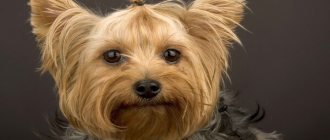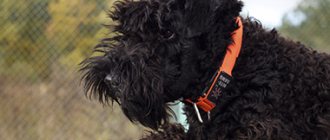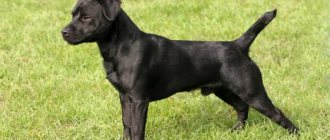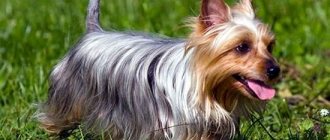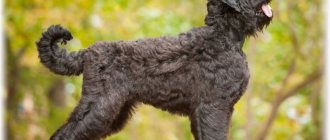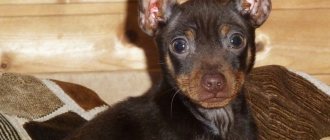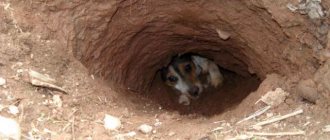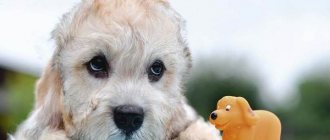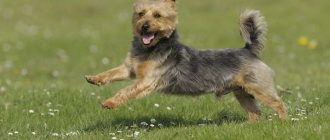0
2029
Article rating
The Czech Terrier is a relatively young hunting dog breed. Bred in the Czech Republic by an amateur breeder. Breeding work began in 1948 and lasted ten years. The parents of the breed were the Seliham Terrier and the Scotch Terrier. The dog received excellent hunting characteristics from its ancestors, but its body shape was improved.
Czech Terrier
Initially, the terrier was intended for burrow hunting of badgers and foxes. Now he is used as a companion and show dog. The breed is quite rare, so finding puppies will not be easy.
External characteristics
This is a short dog with an elongated body and short legs. The height at the withers for girls is 27 cm, for males - 29 cm, body length - 40 cm and 43 cm, respectively. The muzzle is oblong with a slight transition from the forehead to the muzzle. The head is slightly lowered. In appearance, the dog may resemble a Scotch terrier, but the “Czech” has medium-sized triangular ears and a narrower body. The chest circumference does not exceed 45 cm. The weight of the pet can vary from 6 to 10 kilograms. The wool is very soft and silky. It may have a coffee or blue-gray tint. The dog needs to be cut, leaving areas on the paws, belly and chest. On the face, the mustache and hair from the forehead to the nose are not removed. Representatives of this breed have deep-set eyes, their color depends on the base color. So, they can be light brown or dark. The tail is approximately 20 cm long and set low.
Cesky Terrier (Czech Republic)
CZECH TERRIER (Czesky Terrier, English Bohemian, Czech Terrier), a breed of hunting dog. Another name is Bohemian Terrier.
Bred in the Czech Republic in 1940 by crossing Scotch and Sealyham terriers for hunting fox and badger.
The Czech geneticist Frantisek Horak worked on the creation of this breed, who achieved good working qualities and an attractive appearance in the bred breed. The Czech Terrier certainly inherited some traits from the Dandie Dinmont Terrier. The standard was adopted in 1968. A beautiful, strong, squat dog of an elongated format. Height at withers 27-30 cm, weight 6-9 kg. The head is long with a rounded skull. The skull between the ears is not very wide, tapers towards the eyes, the transition from the forehead to the muzzle is weakly expressed. The eyes are small, deep-set, dark brown, light yellow in light brown dogs. The nose is black; in light brown dogs it is light brown. The ears are small, set high, close to the temples. The tail is long (18-20 cm), carried horizontally or slightly lowered. The coat is long, thin, not coarse, and forms a “beard” and “mustache.” The color is bluish-gray or light brown, red, gray and white markings are allowed on the head, throat, chest, belly, paws and under the tail, a white collar and a white tip of the tail. The Czech Terrier is distinguished not only by its beautiful appearance, but also by its good, balanced character, which attracts more and more new fans to this breed. Adapts perfectly to urban conditions. Suitable for guard and sentry service. The wool is cut according to the standard established form. Encyclopedia of Pets KIRILL and MEFODIUS
Breed standards for Cesky Terrier (Czech Republic):
- Temperament (character). According to the standard, the dog must have a calm character. An aggressive animal should be disqualified and excluded from breeding. It is noted that, compared to other terriers, the Czech terrier has a calmer disposition, which makes this breed an ideal choice as a companion dog.
- Head. Long. The nose is large. The beard is thick.
- Eyes. Light chestnut or dark chestnut color. The eyebrows are thick and bushy.
- Ears. Raised on cartilage. The top line of the fold of the ears is above the level of the skull.
- Jaws. The jaws are strong. Scissor bite or straight bite; the dental formula is complete (the absence of two M3 molars in the lower jaw is not penalized). The teeth are strong, regularly spaced, and the position of the jaws is vertical.
- Frame. Sturdy, stretched format. The back of the body is very muscular. The back is slightly convex.
- Limbs. Short, strong.
- Tail. About 20 cm long, when moving it is held at the level of the back.
- Wool. The coat is silky and abundant.
- Color. Grayish blue or light coffee. Puppies are born black and acquire their final color at approximately 2 years of age.
Feeding
A balanced diet for a dog is an important component of good health, proper metabolism and energy of the pet. The owner needs to make a key choice of the type of food - natural or industrial, then everything will depend on the individual characteristics of the pet.
Good quality industrial feed contains all the necessary substances, vitamins and microelements for the full growth and development of the animal. Products are selected strictly according to the physiological needs, age and weight of the dog. Secondary selection criteria are coat type and temperament. You shouldn’t even think about inexpensive food, because this method of feeding is more convenient for the owner, but it is harmful for the dog! Expensive and high-quality food is not always accepted equally well by dogs, so you should not buy new food for future use.
Care and maintenance
The thick coat of this breed requires constant brushing. The Czech Terrier requires regular haircuts - once every two to three months. If the animal is kept in an apartment, it must be walked. This should take at least 40 minutes a day. This breed requires moderate exercise. Although the dog is very resilient, you should not exhaust him too much. After each feeding, wipe the pet's face with a damp cloth. The fur on the face should be lightly combed, since the mustache and beard end up in the bowl. You need to bathe your Czech Terrier when necessary. The dog should always have the opportunity to drink fresh water. Both bowls - for eating and drinking - are cleaned regularly. It is impossible to overfeed or underfeed the animal.
CARE
Despite its small size, it requires a lot of care. Since the coat is long, it needs to be brushed often. Regular brushing will help get rid of dead hair and avoid the formation of tangles. To maintain cleanliness, your dog needs to be washed regularly. Since his coat retains shampoo, it must be washed thoroughly. Washing once every three weeks will be sufficient, but more often is needed for active dogs. To keep the coat in excellent shape, it needs to be trimmed in a special way, leaving the coat short on the back, but long on the belly, sides and paws.
The beauty of the Bohemian Terrier depends on its care. They carefully monitor the appearance of show-class dogs that regularly attend exhibitions. Proper care of the Czech Terrier begins with coat care. From childhood, Czech Terrier puppies get used to a number of activities that turn dogs into handsome dogs.
Breed care includes:
- Combing. Owners of a beautiful skirt learn to comb their hair regularly. Use a long-toothed comb to sort out tangled hair on the skirt, beard, and eyebrows. A massage brush is used to comb the rest of the coat. If the dog is constantly cut short, it is possible to brush it once a week with a brush.
- A haircut. Show dogs are trained from the age of 3 months. Every 2-3 months, the dog’s fur on the back, sides, chest, head and tail is shaved to a length of 1.5 cm. Scissors are used to trim the ends of the skirt, mustache, beard and eyebrows. At 3 months, dogs develop an adult soft light coat; dogs begin to be cut at the specified time.
- Washing. Wash the dog once every 1-2 months as needed. For washing, they use special shampoos that make the coat soft and silky, easy to comb. After washing, the coat becomes fluffy; the procedure is performed 1 month before the exhibition.
- Oral care. The breed has a tendency to dental diseases, and they try to take the dogs to the veterinarian more often. It is permissible to buy a special brush and toothpaste and brush the dog’s teeth yourself. Let them chew on hard bones, avoiding plaque.
- Walks. An active dog requires energy to be directed in a peaceful direction. A smart Czech Terrier is sure to be walked. Try to play with your dog often.
- The dog is suitable for home keeping, sensitive to drafts and temperature changes. Give your pet its own space.
Caring for the Czech Terrier is simple - the dog requires a lot of exercise and a little care for its health. Sticking fur will give your pet a special charm.
Character and habits
The Czech Terrier is famous for its calm disposition. He is kind and affectionate, but at the same time very brave and persistent. His distinctive side can be called a sense of dignity: unlike other terriers, he will not bark in vain or bother his owners if they are busy. The dog is balanced, obedient and capable of training. He is also moderately active, but will not refuse long games, since it is important for him to communicate with his owners. It’s not enough for him when most of his walks are short and without entertainment.
Relationships with people
The Czech Terrier loves every member of his family, but still he chooses only one owner, to whom he will be devoted to the end. The dog prefers company and behaves very good-naturedly. Representatives of the breed love children and get along well with them; they can entertain them for hours. Loneliness is very difficult for a dog. If the dog is left in a locked apartment for a long time, he will begin to have fun on his own, and this usually leads to damage to furniture or other interior items. The terrier treats guests calmly, even friendly. But depending on the situation, the dog may become aggressive and distrustful towards strangers. There is also another trait that the Czech Terrier has: reviews say that if a person hurt him or did something bad, he will not forget him and can take revenge.
Cesky Terrier
Czech Terrier (Bohemian Terrier)
FCI name : Cesky Terrier Country of origin: Czech Republic Date of official publication of the previous standard: 03/11/1997 Use The Cesky Terrier was bred to hunt foxes and badgers, today it is used as a house dog and companion. Classification FCI Group 3. Terriers. Section 2. Small terriers. No operational tests. Brief historical background The Czech Terrier is the product of crossing a male Sealyham Terrier with a female Scottish Terrier in order to obtain an agile, short-legged, well-pigmented terrier with almost drooping ears, easy to care for and easy to train. In 1949, Mr. Frantisek Horak from a place near Prague began to improve the breed by fixing the characteristic features. In 1959, these dogs were first shown at an exhibition, and the breed was finally recognized by the FCI in 1963. General appearance The Czech Terrier is a short-legged, long-haired, well-built and muscular terrier with small, drooping, rectangular ears. Ideal measurements Males Height at the withers - 29 cm. Length of the skull of the Czech Terrier - 21 cm. Width of the skull - 10 cm. Circumference of the chest of the Czech Terrier (behind the elbows) - 45 cm. Oblique length of the body - 43 cm. Bitches Height at the withers - 27 cm The length of the skull of the Czech Terrier is 20 cm. The width of the skull is 9 cm. The girth of the chest of the Czech Terrier (behind the elbows) is 44 cm. The oblique length of the body is 40 cm. Behavior and character The Czech Terrier is a balanced, non-aggressive, pleasant and cheerful companion, easy to train; somewhat reserved towards strangers; calm and kind character. Head The shape of the head of the Czech Terrier resembles a long, blunt, but not too wide wedge, the plane of the forehead forms a distinct ledge towards the back of the nose. Cranial part The skull of the Bohemian Terrier is not too wide between the ears, tapering moderately towards the brow ridges. The occipital protuberance is easily palpable; zygomatic arches protrude moderately. The frontal furrow of the Czech Terrier is only slightly marked. Transition from forehead to muzzle Not emphasized, but obvious. Facial Region Nose The dark, well-developed nose of the Czech Terrier should be black in silver-black shirts and brown-colored in silver-brown terriers. Bridge of the nose The bridge of the nose of the Czech Terrier is straight. Jaws and Teeth The Czech Terrier has strong jaws. Scissor or pincer bite; complete dental formula (the absence of two M3 in the lower jaw is not penalized). The Cesky Terrier's teeth are strong, in a correct linear position and set perpendicular to the jaws. Lips The Czech Terrier is characterized by relatively thick, neatly fitting lips. Cheekbones The cheekbones of the Czech Terrier do not protrude too much. Eyes The Czech Terrier has medium-sized eyes, somewhat deep, with a friendly expression, well covered by overhanging eyebrows. Brown or dark brown in silver-black dogs, light brown in silver-brown dogs. The eyelids are black in silver-black Czech Terriers, brown in silver-brown dogs. Ears The Cesky Terrier's ears are medium sized and hang in such a way as to cover the ear canal well. Set quite high and falling flat along the cheekbones. The shape of the Cesky Terrier's ears resembles a triangle, the shorter side of which falls on the fold of the ear. Neck Medium length, quite strong neck of the Czech Terrier is kept in an inclined position. The skin on the throat is somewhat loose, but does not form a dewlap. Body The body of the Czech Terrier is stretched. The topline is not level, because The loin and croup of the Czech Terrier are always moderately arched. Withers The withers of the Czech Terrier are not very pronounced; The neck is set rather high. Back (from withers to forelocks) The Czech Terrier has a strong back of medium length. Loin The Czech Terrier has a relatively long, muscular, wide, slightly rounded loin. Croup Strongly developed, muscular; The sacrum is moderately inclined. Czech Terriers often have a slight high rear. Chest More barrel-shaped than deep; The ribs of the Czech Terrier are well arched. Belly The Czech Terrier has a voluminous belly that is slightly tucked in. The groins are well filled. Tail Ideal length 18-20 cm; relatively strong, low set. When at rest, the Czech Terrier's tail hangs down or with a slight bend at the end; when excited, the tail is held saber-shaped horizontally or higher. Limbs Forelimbs Straight, bony and parallel. Shoulders The Czech Terrier has muscular shoulders. Elbows The Cesky Terrier's elbows are loose to some extent, however, they turn neither in nor out. Forepaws Large; well arched fingers, strong claws. The Czech Terrier's pads are well developed and thick. Hindquarters The hindquarters of the Czech Terrier are strong, parallel, well angulated and muscular. Shins: The Czech Terrier has short shins. Hock joints: Strongly developed. The Czech Terrier's metatarsus is relatively long. The hind legs are smaller than the front legs. The movements of the Czech Terrier are characterized by free, tireless, strong movements with an energetic push. The gallop is quite leisurely, but steady. The front legs of the Czech Terrier are carried straight forward. Skin The Czech Terrier has strong, dense skin without wrinkles or dewlap, and is pigmented. COAT: The coat is long, fine, but dense, slightly wavy with a silky sheen, but not too overdeveloped. The Czech Terrier is groomed with scissors (grooming). On the front of the head, the hair is not cut; eyebrows and a beard are formed there. On the lower parts of the legs, lower chest and belly of the Czech Terrier, the hair should not be cut anywhere. In show condition, the hair on the upper part of the neck, on the shoulders and on the back should not be longer than 1-1.5 cm; it should be shorter on the sides of the body and on the tail and completely short on the ears, cheekbones, underside of the neck, elbows, hips and around the anus. The transition from clipped areas to unclipped areas in the Czech Terrier should be pleasing to the eye and in no case abrupt. Color The Czech Terrier has two color options: silver-black (puppies are born black), silver-brown (puppies are born chocolate brown). In both color options, yellow, gray or whitish tan markings are allowed on the head (beard, cheekbones), neck, chest, belly, limbs and around the anus. Also, sometimes the Bohemian Terrier has a white collar or a white tail tip. The base color, however, should always predominate. Height and weight Height at withers 25-32 cm. Ideal height for a male Czech Terrier is 29 cm, for a female – 27 cm. Weight should not be less than 6 kg and more than 10 kg. Defects Any deviation from the above points should be regarded as a defect or defect depending on the degree of severity. Light build of the Czech Terrier. Temporary weakening of the pigmentation of the nose (“snowy” nose). Light, short or tapered pincer, poorly developed teeth of the Czech Terrier. Missing one incisor. The Czech Terrier's eyes are too large or protruding. Ears are too large or too small, or of a different shape or position than described in the standard. The Czech Terrier's back is too long or too short. Crooked front legs, incorrect front. The Czech Terrier's coat is too fine or too coarse. Disqualifying faults The Czech Terrier lacks more than 4 teeth in total; absence of 2 incisors or more. The canines occupy a vestibular position. Entropy or ectropy in the Czech Terrier. The chest girth is more than 50 cm. The tail of the Czech Terrier is curled or held over the back. Long brindle shirt in dogs over 2 years of age. The coat of the Czech Terrier is coarse or curly, cotton-fluffy type. White markings covering more than 20% of the body; white mark on the head. Incorrect, shaking, constrained movements of the Czech Terrier. Weight more than 10 kg or less than 6 kg. Cowardice, unbalanced or aggressive character of the Czech Terrier. Note Male Czech Terriers must have two normally developed testes, fully descended into the scrotum.
Tips for choosing a puppy
We are talking about a very rare, small breed, so finding Czech Terrier puppies is not so easy. Nurseries that have proven themselves to be good are located in America and the Czech Republic. Puppies are booked in advance and assessed after birth. According to generally accepted practice, the algorithm of actions is as follows:
- Contact the nursery - all organizations have websites, although most of them are in English.
- Express your wishes – gender and class (show, breed, pet) of the puppy.
- Discuss upcoming litters for which reservations are still open.
- Wait and save money, since a puppy cannot cost less than $500-600, and besides the dog, you need to purchase many accessories, pay for veterinarian services, etc.
Price, waiting periods and (most importantly) the conditions under which puppies are sold are individual factors that depend only on the owners of the kennel. The higher the prospects of the litter, the more likely it is that the puppies will be sold under a co-ownership agreement. Simply put, you will need to fulfill the conditions and only then the dog will become completely yours. Most often we are talking about one litter of puppies to continue the bloodline.
Important! Never buy rare dogs secondhand, and especially without a full package of documents! If you don’t have experience, get advice. If you “fall for” fairy tales from dishonest sellers, this is only your responsibility.
Czech Terriers rarely get sick if you pay attention to the issue of disease prevention. Genetically, the breed is considered healthy, but it cannot be said that it is absolutely free of hereditary diseases. Typical ones include:
- Dislocation of the kneecap;
- Scotch Terrier seizures caused by a lack of serotonin;
- Lens luxation.
In old age, it is possible to develop senile diseases, including heart and kidney failure, malignant and benign tumors, problems with joints and gastrointestinal tract. To maintain health, it is important to promptly treat your Czech Terrier for external and internal parasites, vaccinate according to the schedule, and undergo a full medical examination from time to time. Life expectancy is usually between 12 and 15 years.
Attitude towards animals
Often people who purchase a Czech Terrier already have other pets at home. These could be dogs or cats. “Czech” treats them friendly and regards them as his comrades with whom he can frolic. Therefore, we can say that representatives of this breed are non-conflicting. If there is a quarrel between other animals, the Czech Terrier will prefer not to be a participant in it and will watch the situation on the sidelines. But do not forget that this breed was bred as a hunting breed, so the dog perceives all kinds of rodents as prey and can harm and even strangle them.
Nutrition
Dogs of this breed are not particularly picky when it comes to food, they are even rather voracious. They practically know no limits and look at their owners with hungry eyes all day long. It is recommended not to indulge their touching begging, otherwise they will not leave the table while the owners are eating. This phenomenon should be stopped from early childhood.
It is also important to stop theft from puppyhood, since the dog will steal food from the table, street trash can, and pick up food from the floor. This can cause harm to his health: the animal will be poisoned, swallow a foreign object, and obesity is also possible.
It is better to feed dogs natural food. The main product in the diet should be meat, and raw meat is better, since it contains more healthy elements. Additionally, it is advisable to include vitamins and various mineral supplements.
Character Flaws
It is a big plus that these dogs have no predisposition to diseases. But after exhausting exercise, cramps are possible. This can frighten the Czech Terrier's owners. Dog breeds, such as the terrier variety in question, do not cause problems for their owners in terms of diseases, but they do have another drawback. Yes, they love to eat. Moreover, we are talking not only about the special food offered by the owner. So, they can dig through garbage cans and pick up leftover food on the street. Also, while at home, “Czechs” steal from the table, climbing on it, or deftly pull out treats from bags. They can also tear apart a garbage bag. This problem can be solved if you stop such attempts from the very first days the puppy appears in the house. Therefore, training should begin as early as possible. Although the dog is very obedient by nature and does not have stubbornness, like other terriers, your pet will still have to clearly show what is prohibited.
Breed characteristics and character
a photo of a Czech Terrier without feeling moved. But you can get even more pleasure if you have such a dog in your home. Czech, or Bohemian, terriers have a calm but active character.
Since the dog is a hunting dog, he moves a lot. The terrier is very hardy, so it can become a good hunting assistant. He can even hunt on his own, and his victims in this case will be badgers, foxes and other small inhabitants of burrows.
buying a Czech Terrier for the purpose of protecting the territory. The dog does not pose a serious danger to people entering or passing the yard. However, he will not let strangers pass so easily. Complete devotion to the owners will prompt him to first of all notify the family about guests, and, if necessary, to protect the yard.
, Czech Terrier dogs behave freely, but without displays of aggression. You can safely let even children play with such a dog, without worrying that he will harm the kids.
Like most dogs, the Bohemian Terrier tends to feel a strong attachment to its owner and his entire family. He doesn’t like to be alone at home, so don’t be surprised if, after leaving the dog alone for a long time, you return to the house where a little chaos was created by his will.
The Czech Terrier is ready to do anything to earn the praise of his family. Therefore, he does not show aggression towards other animals that live in the same room where he does.
Walking with such a dog is a pleasure, because he moves at a balanced speed, and also never provokes dog fights. There is only one type of animal for which the terrier has a mutual dislike - rodents. For this reason, it is best to avoid areas where there may be mice, rats or hamsters, or be prepared for your dog to hunt them.
Dog diseases
The Czech Terrier is a healthy dog. He rarely catches colds and is adapted even to cold climates. If you carefully monitor your diet and don’t let your dog pick up scraps, you can protect him from intestinal infections and digestive disorders. To protect against infectious diseases, vaccinations are required.
Czech Terriers have a hereditary nervous system disorder called Scotty Crump Syndrome. He inherited it from a Scottish ancestor. It manifests itself as sudden convulsions during physical or emotional stress.
After the attack, the dog returns to normal again; this does not in any way affect its further behavior or health; terriers do not die from seizures. The average lifespan of a dog is 10-12 years. With proper care and a healthy diet, the Czech Terrier can live longer.
Health
The Czech Terrier has good health and an active life expectancy of at least 10-12 years.
The only thing that can greatly frighten the owner is periodic convulsions that disrupt the dog’s coordination. This disease, inherited from Scottish ancestors, is called Scotty Crump syndrome, but it occurs in a small percentage of individuals. Convulsions usually end quickly without causing damage to the general condition of the animal.
A tendency to gluttony can cause obesity; eating stale food found, for example, while walking, can lead to intestinal and other infections, and the appearance of worms. Therefore, your babies must be vaccinated and dewormed once a quarter.
It is important to monitor the condition of your teeth - this is another weak point. Preventive examinations of the condition of the mucous membranes and bone tissue in the mouth are required, and for prevention, cleaning with a special paste for dogs.
Reviews about “Czechs”
Although there are still few dogs of this breed in our country, those who managed to acquire this pet are satisfied. Dog owners share that they are very unpretentious in their diet. This breed is also perfect for keeping in an apartment, since its representatives do not shed and are very friendly and sociable. Other owners say that they live in the house and their Czech Terrier plays the role of an excellent watchdog. Therefore, those who are thinking about purchasing this dog can rest assured of his devotion and pickiness.
Care and maintenance of the Czech Terrier
The Czech Terrier dog requires special care, as it has luxurious long hair. Your pet should be accustomed to the necessary procedures from childhood.
Care that the Czech Terrier needs:
- It needs to be brushed regularly. Although this procedure will not be particularly pleasant for them at first, they will soon get used to it. Use a long-toothed comb to comb your skirt and beard. The rest of the coat can be combed with a massage brush. If your dog gets frequent haircuts, you can only groom him with a brush.
- Czech Terrier puppies need to be clipped starting at three months of age. This includes trimming the skirt and beard, as well as trimming the tail, head, chest and back hair. You need to visit the hairdresser or trim your pet’s hair yourself once every couple of months.
- Dogs of this breed should be washed approximately once every four weeks. If necessary, this can be done more often. During this procedure, special shampoos should be used to soften the coat. If the dog is participating in an exhibition, you should not wash it before the exhibition, since the coat will be too voluminous after bathing.
- Visits to the veterinarian should be regular due to the fact that the Czech Terrier is prone to dental diseases. To avoid them, you can brush your dog’s teeth with a special brush and toothpaste, and also give him hard bones.
- If you are going to buy a Czech Terrier puppy , you should understand that you will have to walk him a lot. Since dogs of this breed are very active, walks should include games.
- It is better to keep the Czech Terrier in the house, allocating for it its own place there, to which it will be accustomed from childhood.
Choosing a Czech Terrier puppy
Those wishing to purchase a Czech Terrier will have to try hard to find a kennel, not to mention puppies available for sale. The main livestock is concentrated in the Czech Republic and Great Britain; there are several breeders in other European countries and America. In Russia, very few people successfully breed Czech terriers.
The only proof of a puppy's breed are documents of the FCI-RKF sample.
Czech Terrier puppies are born black with white spots on the body and only by the age of two years they acquire their final color, from charcoal gray to almost white. It is very rare for brown puppies to appear in a litter. The color of the parents can only suggest the future color of the puppies, but does not guarantee it.
Vaccinated babies are taken no earlier than 2 months of age and their compliance with the standard and health are assessed. Externally, puppies should not show signs of illness. Parents are encouraged to have genetic tests for common diseases. It is better to pick up the puppies in person. This will allow you to see your parents live, their appearance, character and habits.
Since the breed is not commercial, and puppies are in little demand, the price of the Czech Terrier is quite reasonable. Dogs not for exhibitions and breeding cost an average of 35,000 rubles. In Europe, the average cost of a Czech Terrier puppy is 700 euros.
We are talking about a very rare, small breed, so finding Czech Terrier puppies is not so easy. Nurseries that have proven themselves to be good are located in America and the Czech Republic. Puppies are booked in advance and assessed after birth. According to generally accepted practice, the algorithm of actions is as follows:
- Contact the nursery - all organizations have websites, although most of them are in English.
- Express your wishes – gender and class (show, breed, pet) of the puppy.
- Discuss upcoming litters for which reservations are still open.
- Wait and save money, since a puppy cannot cost less than $500-600, and besides the dog, you need to purchase many accessories, pay for veterinarian services, etc.
Price, waiting periods and (most importantly) the conditions under which puppies are sold are individual factors that depend only on the owners of the kennel. The higher the prospects of the litter, the more likely it is that the puppies will be sold under a co-ownership agreement. Simply put, you will need to fulfill the conditions and only then the dog will become completely yours. Most often we are talking about one litter of puppies to continue the bloodline.
Description of the Czech Terrier breed
The Czech mini terrier, bred half a century ago, grows only up to thirty centimeters in its life. Moreover, its weight is usually about nine kilograms. Here are some other features of this breed:
— Dogs of this breed can live up to fifteen years, although their average age is ten or eleven years;
— They have a strong, elongated body and a voluminous chest;
— The shape of the abdomen is smooth and elongated;
— The lumbar area has a convex type;
— The most common color of the Czech Terrier is gray or beige, sometimes with a bluish tint. The beard and eyebrows may contain gray hair . Czech Terrier puppies are black at birth, and as they grow up their coat becomes lighter.
— The shape of the head is rounded, with a smooth transition between the forehead and muzzle.
- The neck is of moderate length and has a slight slope.
— The dog has short legs covered with long hair, but at the same time it moves quickly. To gain speed well, the terrier has strong hind legs. The dog is not good at jumping.
— The nose of the Czech Terrier is black or dark brown, depending on the shade of the coat.
— Small round eyes are covered by bushy eyebrows.
— Ears are triangular in shape.
— The Czech Terrier has a scissor bite, so cases of overbite or underbite are considered unacceptable.
— The length of the tail reaches twenty centimeters.
Additional Information
This breed was officially recognized in 1963. But she was first presented at an exhibition in 1959. She was bred in Czechoslovakia by dog breeder Frantisek Horak. He worked on the problem for 10 years and eventually got a new breed with excellent qualities of a burrow hunter and at the same time possessing pleasant accompanying qualities and appearance. These characteristics were obtained by crossing two varieties of terriers - Scotch and Sealyham.
Today, this breed is beginning to gain popularity, and many families would like to have a Czech Terrier as their pet. The price of a dog is quite high, since this species is not yet very common in our country. On average, such a puppy can be purchased for $800. Although in most cases the breed is kept as a pet, they can also become excellent companions for avid hunters. The approximate life expectancy of a “Czech” is 11 years.
History of the breed
The breed was developed by crossing the Scottish Terrier and the Silichim Terrier. It was created by Frantisek Horak. He worked as a geneticist at the Academy of Sciences. The creation of the Czech Terrier is part of his scientific work. Frantisek was an avid hunter and had a Scotch Terrier dog. He took the existing dogs for hunting and work. In his opinion, the Scotch Terrier was more aggressive than required, and he also wanted to breed a dog with a narrower chest so that the dog could crawl into holes. Having seen the Silichim Terrier, he decided to cross both breeds.
After the end of World War II, his work began. The Czech Terrier (one puppy) appeared in 1949. Horak carefully monitored the progress of the work and wrote down all the results obtained. During the hunt, the first representative of the breed was killed, after the second crossing, 6 puppies appeared.
In 1959, the breed took part in the exhibition for the first time, a few years later it was recognized by the Czech Kennel Club, and in 1963 by the FCI. In 1964, the breed received champion status, after which it spread to other countries.
In 1984 and 1985, Gorak again added blood from the Silichim Terrier to consolidate the result. In 1987, the breed came to America. It is becoming very popular, but is recognized as one of the rarest in the world.
Training
This is one of the few breeds of small dogs that can be easily trained. “Czechs” are smart and try to please their master, hence their great obedience. But sometimes a dog can still be stubborn. The peculiarity of the breed is intelligence, ability to learn, and perseverance.
To prevent the puppy from becoming uncontrollable, cynologists and breeders advise carrying out a number of activities for their early socialization. Some owners ignore training courses, and subsequently suffer from the uncontrollability and willfulness of their small pets, which can cause a lot of problems and troubles. Dog training should begin in early childhood. This is a good-natured animal in which aggression does not need to be trained. A pet for a family will become a real companion, a watchman, or will play with children. With proper socialization, the dog will not conflict with other animals, except, of course, rodents - its natural prey.
Czech Terrier
Origin
This relatively new breed, the national dog of the Czech Republic, was created by Frantisek Horak, a breeder and geneticist, in 1949. Gorak loved hunting very much. He decided to cross the Scottish Terrier with the Sealyham Terrier. He sought to develop a smaller dog that would work as a team and could also hide in holes that Scotch and Sealyham terriers could not fit into. The Czech Terrier was used to hunt any animal - from foxes, rabbits, birds to wild boars!
Character
The Czech Terrier is an affectionate dog towards people. He can be reserved with strangers, but friendly with acquaintances. His work instincts are still strong. This is a strong, flexible, energetic and hardy dog. She can be stubborn, but with the right motivation she will show a different side and even win dog competitions in obedience and speed.
Behavior
They may be small dogs, but they don't seem to know it! These dogs have a lot of personality and often make a lot of noise. They make excellent companions for people who love to explore, dig, think quickly, and have energetic fun. Despite their size, they need a lot of physical activity and stimulation. It is also necessary to provide an outlet for their need to tear, tear, drag and chew something. Despite careful training, they can get along with their own cats, but may not be friendly towards other cats or small furry animals.
Health (problems)
The Czech Terrier is generally in good health. However, like many other small breeds, they can also suffer from some problems with their kneecaps, which can temporarily slip out of place (patella luxation).
Physical exercise
The Czech Terrier requires one hour of exercise per day. His hunting instincts may sometimes come out during off-leash walks. Therefore, you need to train your dog to consistently respond to its name before letting it off leash in public places.
Nutrition
Toy breed dogs have a fast metabolism. This means they burn energy at a high rate. Because their stomach capacity is very small, they must eat small, frequent meals. Small breed foods are specially formulated to meet your dog's specific nutritional needs. In this case, the products are crushed taking into account the small size of the dog’s jaw, which, in turn, facilitates the chewing process and improves digestion.
Grooming
Their slightly wavy, medium-length coat requires careful grooming, although not as intensive as most terriers, which require manual removal of dead hair. Your dog should be groomed every six to eight weeks and brushed at least once a week. Particular attention should be paid to long hairs on the face, paws and belly.
The best breeds for children
Dogs are generally considered to be good with children. However, dogs and children must learn to get along with each other, respect each other and feel safe being together. In any case, small children should not be left alone with a dog; adults must supervise all interactions between them.
